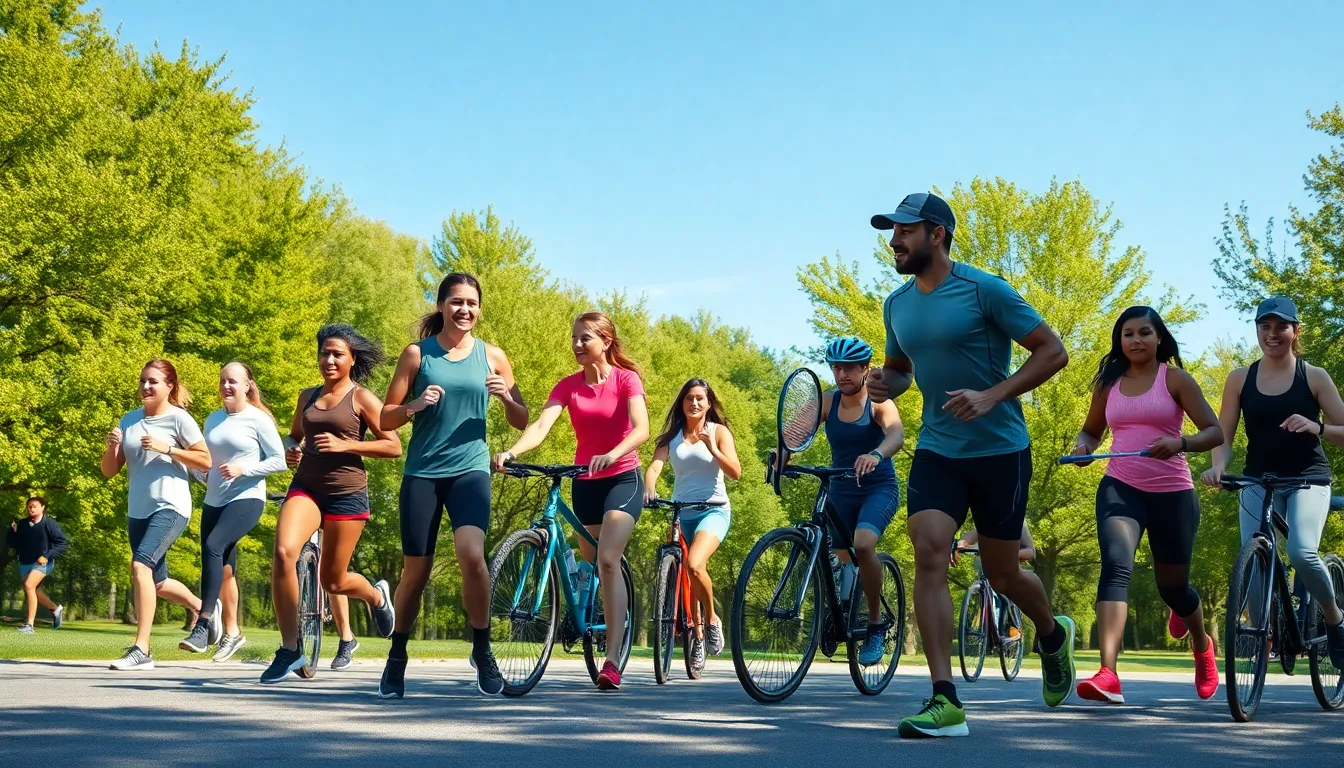When it comes to sports gear, choosing the right equipment can feel like a game of dodgeball—if you miss the mark, you might just get hit hard. From running shoes that promise to make you feel like you’re flying to yoga mats that claim to be softer than a cloud, the options are endless. But let’s face it, not all gear is created equal.
Table of Contents
ToggleOverview of Sports Gear
Sports gear encompasses a wide variety of equipment designed to enhance performance and safety during athletic activities. This equipment includes items like footwear, clothing, protective gear, and accessories catering to different sports. Quality plays a crucial role in a player’s experience; high-grade materials contribute to better support, comfort, and durability.
Selecting the right footwear remains one of the most vital choices. Running shoes should offer optimal cushioning, while court shoes provide lateral support for sports like basketball and tennis. Athletes should consider the surface they’ll play on when choosing their shoes, as traction varies across different types.
Clothing also impacts comfort and performance. Moisture-wicking fabrics help athletes stay dry and regulate body temperature during intense workouts. Layering can be essential for outdoor activities, allowing for adjustments based on weather conditions.
Protective gear is another critical aspect of sports equipment. Helmets, pads, and guards are designed to minimize injury risk. Athletes participating in contact sports must prioritize proper fitting to ensure maximum protection.
Accessories such as hydration packs, fitness trackers, and workout gloves enhance training effectiveness. Hydration packs allow for easy access to water during long sessions, while fitness trackers monitor performance metrics. Coaches emphasize the importance of these tools in establishing progress and setting goals.
Investing in quality sports gear directly correlates with performance outcomes. Players equipped with the right gear experience improved comfort, reduced injury risk, and enhanced overall enjoyment.
Types of Sports Gear

Various types of sports gear exist to meet different athletic needs. These encompass apparel, footwear, and equipment, each playing a vital role in enhancing performance and safety.
Apparel
Athletes prioritize moisture-wicking apparel for comfort. Fabrics that draw sweat away promote dryness, especially during intense activities. Layering options work well for outdoor sports, allowing for adjustments to weather changes. Compression clothing supports muscle performance and recovery. Athletes should choose breathable materials to ensure optimum airflow. Performance-focused designs feature ergonomic cuts for unrestricted movement. Selecting the right fit contributes to overall confidence and focus during sports activities.
Footwear
Footwear types matter greatly in sports performance. Running shoes provide essential cushioning and support for impact absorption. Court shoes feature specialized traction for stability during quick movements. Proper fit can prevent injuries, with enough space for toes to move freely. Selecting shoes based on the specific sport ensures athletes receive maximum benefits. Trail shoes offer durability and grip on rugged surfaces. Sports sandals serve well for water-based activities, providing comfort and security.
Equipment
Equipment varies widely based on the sport engaged in. Bicycles designed for road or mountain purposes enhance performance in cycling. Weights and resistance bands facilitate strength training and muscle building. Protective equipment, such as helmets and pads, reduces injury risks in contact sports. Rackets, balls, and nets provide essential components for racquet sports and games. Hydration systems ensure athletes maintain fluid levels, especially during strenuous workouts. Choosing quality equipment can lead to significant advancements in skill and enjoyment.
Choosing the Right Sports Gear
Selecting the right sports gear significantly affects performance and enjoyment. Proper choices enhance safety and comfort in athletic activities.
Size and Fit
Finding the correct size ensures comfort during workouts. Sizes vary across brands, so athletes must try gear on before purchasing. A snug but not restrictive fit promotes stability in footwear, which is essential for running and court sports. Clothing should offer freedom of movement without being baggy, as loose fabrics can get caught during activity. Proper fit prevents distractions and allows athletes to focus on their performance. When purchasing protective gear, ensure it adequately covers the relevant areas without hindering mobility.
Material and Durability
Material selection influences durability and performance. High-quality materials like synthetic fibers or performance blends resist wear and tear, offering long-lasting use. Moisture-wicking fabrics help maintain dryness by drawing sweat away from the skin, essential for maintaining comfort during intense sessions. Breathable materials regulate temperature, keeping athletes cool in warm weather. Durability becomes crucial for equipment, especially in sports involving rigorous use, like cycling or weightlifting. Investing in gear made from premium materials directly contributes to better performance and athlete longevity.
Popular Brands in Sports Gear
Multiple brands dominate the sports gear market, recognized for quality and innovation. Nike leads in athletic footwear, known for its cutting-edge designs and performance technologies. Adidas follows closely, offering a strong range of apparel and footwear for various sports activities. Under Armour also stands out, specializing in performance apparel engineered to keep athletes dry and comfortable during workouts.
Puma emphasizes style alongside functionality, appealing to both serious athletes and casual users. New Balance focuses on running footwear, with a commitment to comfort and fit that caters to long-distance runners. Asics remains popular among runners, celebrated for its advanced cushioning technology and support systems.
Reebok targets fitness enthusiasts, providing equipment and apparel tailored for workouts and training regimes. Columbia and The North Face are preferred for outdoor gear, combining durability and weather resistance for hiking, climbing, and other outdoor pursuits.
Lifestyle brands like Lululemon and Gymshark are gaining traction in the athleisure sector, merging style with performance for everyday wear. Each brand offers distinct features, catering to specific needs and preferences. Athletes often prioritize brands that align with their sport and personal style, ensuring optimal performance and comfort.
Quality assurance across brands can vary, making research important before purchasing. Reviews from other users can provide insights into the durability and performance of sports gear. Selecting the right brand enhances the overall athletic experience, underscoring the importance of choosing equipment that fits personal requirements and enhances performance.
Choosing the right sports gear is essential for maximizing performance and ensuring safety during athletic activities. Quality materials and proper fit can make a significant difference in comfort and effectiveness. Athletes should prioritize researching brands and understanding their specific needs to find gear that truly enhances their experience. Investing in well-made equipment not only supports physical activity but also contributes to overall enjoyment in sports. With the right approach to selecting sports gear, individuals can elevate their performance and embrace their athletic journey with confidence.









